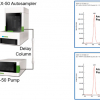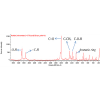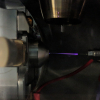Mark A. Sephton
Impacts and Astromaterials Research Centre, Earth Science and Engineering, Imperial College London, London SW7 2AZ, UK. E-mail: [email protected]
Meteorites and organic matter
The asteroid belt is littered with the left- over materials from planetary construction. Objects that never coalesced to form larger bodies represent time capsules created shortly after the birth of the solar system around 4.6 billion years ago. The processes which preceded planet formation are decipherable using the correct tools and procedures. Although expensive and adventurous space missions have visited asteroids and returned small amounts of material to Earth, much larger amounts are delivered to the Earth naturally in the form of meteorites (Figure 1). Fragments of asteroids, often produced by collisions, cross the Earth’s orbit and are ensnared by its gravitational pull.

The study of meteorites reveals a range of types that indicate various forms and levels of processing by heat and water but the most primitive type are the carbonaceous chondrites that contain up to several percent organic matter. These organic-rich objects from space have been the subject of fascination for centuries. As carriers of bona fide non-biological organic matter that predates the origin of life on Earth, meteorites provide a valuable insight into the organic chemical evolution of the solar system and the first chemical steps towards biological systems. There are various proposed source regions for the organic matter in meteorites and they include interstellar clouds, the protoplanetary disk and the asteroidal meteorite parent body. Hence, the journey for meteorite organic matter can begin before the solar system existed and can end in Earth laboratories where meteorites are studied (Figure 2).

The organic matter in meteorites is present as a range of molecular weights. Low molecular weight compound classes include aliphatic and aromatic hydrocarbons, amino acids, nucleic acid bases, carboxylic acids, phosphonic acids, sulfonic acids and sugar-related compounds.1 Yet the low molecular weight compounds are minor components relative to a high molecular weight, predominantly aromatic, network. This network has been referred to by several names, including kerogen-like material and insoluble organic matter, although the former term has biological connotations in geochemistry while the latter begs the question, insoluble in what? In an attempt to avoid ambiguity, the author has traditionally used the generic term macromolecular material.
Analytical tools
The structure of the macromolecular material has been investigated using non-degradative techniques such as nuclear magnetic resonance spectroscopy and X-ray absorption near edge structure spectroscopy. Yet direct access to meteorite macromolecular units is provided by degradative methods, perhaps the most common of which is pyrolysis, which subjects the macromolecular material to thermal fission.2 Once liberated, macromolecular entities can be characterised and their record of macromolecular material construction and subsequent processing read with the aid of spectroscopic techniques.
Pyrolysis can be used as an on-line or off-line technique, with the former providing analytical efficiency and the latter allowing flexibility of product pre-treatment before characterisation. Examples of on-line pyrolysis of macromolecular material in meteorites include a number of “hyphenated techniques” such as direct insertion-mass spectrometry,3 pyrolysis gas chromatography-mass spectrometry, pyrolysis-gas chromatography-isotope ratio-mass spectrometry,4 thermochemolysis-gas chromatography-mass spectrometry5,6 and pyrolysis-Fourier transform infrared (FT-IR) spectroscopy.7 Examples of off-line pyrolysis of macromolecular material in meteorites include hydrous pyrolysis8 where water is in direct contact with the sample for the duration of the experiment and hydropyrolysis9 where pyrolysis is assisted by high hydrogen gas pressures and a dispersed catalytically-active phase.
Pyrolysis and the meteorite macromolecular material
Pyrolysis has revealed that the macromolecular material comprises condensed aromatic cores, connected by aliphatic and ether linkages and with various functional groups attached. Macromolecular materials from different carbonaceous chondrites look similar, suggesting a common origin.10 The implications are that the asteroids sampled a common and widespread organic material during their formation. Although, quantitative assessment indicates that, despite displaying superficial chemical similarities, differing levels of processing following accretion has led to variations in macromolecular constitution between meteorites. The macromolecular material, therefore, chronicles primary and secondary chemical reactions and is a valuable indicator of the early solar system and its organic constituents.
Pyrolysis can also reproduce processes that occurred on the meteorite parent body. The structural similarities between the free aromatic hydrocarbons in meteorites and pyrolysis fragments of macromolecular material led to suggestions that the two fractions are connected by a natural pre-terrestrial degradation event. Off-line hydrous pyrolysis of the macromolecular material (Figure 3) and compound-specific carbon isotope ratio analysis of the aromatic hydrocarbons in both the free fraction and pyrolysis products has indicated a clear correlation for these units but with the free compounds containing more of the reactive light carbon isotope. The data imply the preferential release of macromolecular units during what was probably the oldest oil generation event in the solar system.8

Aromatic macromolecular organic matter is not only found in meteorites and appears common throughout the Cosmos. The connection between the organic matter observed remotely in interstellar space [Figure 2(a)] and that recognised in meteorites has often been postulated. This assertion is supported by enrichments in the heavy isotope of hydrogen in meteorite macromolecular materials. Deuterium is concentrated in interstellar environments during the ion–molecule reactions that take place there. Yet one obstacle standing in the way of the interstellar–meteorite connection is the size difference in the two locations. The one- to four-ring polycyclic aromatic hydrocarbons (PAH) commonly released by pyrolysis of macromolecular material from meteorites contrast with the greater than 20-ring PAH proposed for the interstellar medium. Highly efficient pyrolysis techniques followed by gas chromatography-mass spectrometry have, however, detected up to seven-ring PAH units from the macromolecular material in the Murchison meteorite.9 Moreover, examination of the experimental residue and comparison with terrestrial equivalents suggest that even larger entities must be present in the experimental residue. These data have reconciled the apparent disharmony between the meteoritic and interstellar organic inventories.
Pyrolysis and life
Studies of meteorites commonly focus on the material which survives to reach the Earth’s surface, but the majority of an infalling meteorite is ablated during passage through the atmosphere [Figure 2(d)]. Pyrolysis studies can recreate this process and characterise and quantify the volatiles lost (Figure 4). The gases generated include water, carbon dioxide, methane and sulfur dioxide.7,11 Such pyrolysis studies have provided new insights into the delivery of gases to planetary surfaces and their role in the formation and modification of our atmosphere and oceans during the intense late heavy bombardment early in Earth’s history. It appears that climate-changing quantities of carbon dioxide and water may have been provided by meteorite gases. The warming effects of meteorite-derived gases are particularly relevant to the early Earth, at which times our young Sun would have had a reduced luminosity (75%) compared to the present day. The extra meteorite-derived gases would have helped to increase temperatures, stopping the Earth freezing, thereby avoiding life’s extinction.

One topical subject is the source of methane in the Martian atmosphere which has been detected by remote infrared spectroscopy.12 On Earth, the presence of methane most often indicates the activity of life and similar assertions have been made for the Martian gas. Yet non-biological interpretations for methane are possible and include hydrothermal alteration of igneous rock (serpentinisation), volcanism and meteorite infall. Volcanism produces gases other than methane and these do not appear on Mars and pyrolysis studies have discounted meteorite ablation as a major contributor.13 These conclusions leave serpentinisation, or even life, as remaining possibilities.
The alteration of meteoritic macromolecular materials in the presence of water on the early Earth could act as a source of prebiotic organic matter.14,15 Hydrous pyrolysis studies indicate that aqueous processing of meteoritic macromolecular materials leads to the release of organic compounds that could contribute to the inventory of biologically relevant compounds. Some of the molecules generated by the hydrous pyrolysis of meteorite macromolecular materials have both hydrophobic and hydrophilic parts and could act as self-organising membrane molecules. Hydrothermal environments in which meteorite macromolecule degradation would take place were widespread in the early solar system. Large impacts, themselves, generate heat and induce hydrothermal activity in the surrounding area, suggesting that large meteorites can provide the raw material of life and the heat necessary to induce further chemical evolution.
Pyrolysis and Mars
Pyrolysis has not only been used for meteorites from asteroids, however, and meteorites from Mars have also been studied in this way. Ejected from the near surface of Mars by large impacts, these rocks appear to contain macromolecular organic matter. Aliphatic and aromatic hydrocarbons have been liberated from solvent extracted samples and pyrolysis data suggest a superficial similarity to the organic matter in carbonaceous chondrites some of which may have been contributed during the impact-induced ejection event.16
As an effective mobiliser of the major organic components in samples, it should be no surprise to see pyrolysis used in combination with spectrometry on missions to Mars. The Viking landers which operated on Mars in 1976 used pyrolysis techniques in an attempt to detect organic matter.17 The Mars Science Laboratory mission, which began operations in 2012, also contains a pyrolysis system for organic detection.18 The future ExoMars mission will use a Mars Organic Molecule Analyzer containing a pyrolysis system for the extraction and introduction of organic compounds.19 ExoMars will use a drill to dig deep into the Martian surface and avoid any oxidation problems thought to have precluded organic detection on Viking.
Conclusions
The practice of taking material that has survived billions of years of solar system history and subjecting it to destructive thermal fission is laced with irony. Yet these pyrolysis techniques, in combination with spectroscopic analysis, are helping us to understand how our solar system was furnished with organic matter. Moreover, they are revealing how secondary processing of meteorite materials appears to enhance the abilities of atmospheres to host life on planetary surfaces as well as providing the raw materials from which life could originate. The potent combination of pyrolysis and spectroscopy will continue to provide insights into the origin and distribution of life in the solar system by searching for the remains of life on other planets.
References
- M.A. Sephton, “Organic compounds in carbonaceous meteorites”, Nat. Prod. Rep. 19, 292 (2002). doi: 10.1039/b103775g
- M.A. Sephton, “Pyrolysis and mass spectrometry studies of meteoritic organic matter”, Mass Spectrom. Rev. 31, 560 (2012). doi: 10.1002/mas.20354
- J.M. Hayes and K. Biemann, “High resolution mass spectrometric investigations of the organic constituents of the Murray and Holbrook chondrites”, Geochim. Cosmochim. Acta 32, 239 (1968). doi: 10.1016/S0016-7037(68)80006-7
- M.A. Sephton and I. Gilmour, “Pyrolysis–gas chromatography–isotope ratio mass spectrometry of macromolecular material in meteorites”, Planet Space Sci. 49, 465 (2001). doi: 10.1016/S0032-0633(00)00163-X
- L. Remusat, S. Derenne, F. Robert and H. Knicker, “New pyrolytic and spectroscopic data on Orgueil and Murchison insoluble organic matter: A different origin than soluble?”, Geochim. Cosmochim. Acta 69, 3919 (2005). doi: 10.1016/j.gca.2005.02.032
- J.S. Watson, M.A. Sephton and I. Gilmour, “Thermochemolysis of the Murchison meteorite: identification of oxygen bound and occluded units in the organic macromolecule. Int. J. Astrobiol. 9, 201 (2010). 10.1017/S1473550410000194
- R.W. Court and M.A. Sephton, “Meteorite ablation products and their contribution to the atmospheres of terrestrial planets: An experimental study using pyrolysis-FTIR”, Geochim. Cosmochim. Acta 73, 3512 (2009). doi: 10.1016/j.gca.2009.03.006
- M.A. Sephton, C.T. Pillinger and I. Gilmour, “δ13C of free and macromolecular aromatic structures in the Murchison meteorite”, Geochim. Cosmochim. Acta 62, 1821 (1998). doi: 10.1016/S0016-7037(98)00108-2
- M.A. Sephton, G.D. Love, J.S. Watson, A.B. Verchovsky, I.P. Wright, C.E. Snape and I. Gilmour, “Hydropyrolysis of insoluble carbonaceous matter in the Murchison meteorite: New insights into its macromolecular structure”, Geochim. Cosmochim. Acta 68, 1385 (2004). doi: 10.1016/j.gca.2003.08.019
- M.A. Sephton, C.T. Pillinger and I. Gilmour, “Aromatic moieties in meteoritic macromolecular materials: Analyses by hydrous pyrolysis and δ13C of individual compounds”, Geochim. Cosmochim. Acta 64, 321 (2000). doi: 10.1016/S0016-7037(99)00282-3
- R.W. Court and M.A. Sephton, “The contribution of sulphur dioxide from ablating micrometeorites to the atmospheres of Earth and Mars”, Geochim. Cosmochim. Acta 75, 1704 (2011). doi: 10.1016/j.gca.2011.01.029
- M.J. Mumma, G.L. Villanueva, R.E. Novak, T. Hewagama. B.P. Bonev, M.A. DiSanti, A.M. Mandell and M.D. Smith, “Strong release of methane on Mars in northern summer 2003”, Science 323, 1041 (2009). doi: 10.1126/science.1165243
- R.W. Court and M.A. Sephton, “Investigating the contribution of methane produced by ablating micrometeorites to the atmosphere of Mars”, Earth Planet Sci. Lett. 288, 382 (2009). doi: 10.1016/j.epsl.2009.09.041
- M.A. Sephton and I. Gilmour, in Impacts and the Early Earth, Ed by I. Gilmour and C. Koeberl. Springer, Heidelberg, Germany (1999).
- H. Yabuta, L.B. Williams, G.D. Cody, C.M.O. Alexander and S. Pizzarello, “The insoluble carbonaceous material of CM chondrites as possible source of discrete organics during the asteroidal aqueous phase”, Meteorit. Planet. Sci. 42, 37 (2007). doi: 10.1111/j.1945-5100.2007.tb00216.x
- M.A. Sephton, I.P. Wright, I. Gilmour, J.W. de Leeuw, M.M. Grady and C.T.Pillinger, “High molecular weight organic matter in Martian meteorites”, Planet Space Sci. 50, 711 (2002). doi: 10.1016/S0032-0633(02)00053-3
- K. Biemann, J. Oro, P. Toulmin, 3rd, L.E. Orgel, A.O. Nier, D.M. Anderson, P.G. Simmonds, D. Flory, A.V. Diaz, D.R. Rushneck and J.A. Biller, “Search for organic and volatile inorganic compounds in two surface samples from the Chryse Planitia region of Mars”, Science 194, 72 (1976). doi: 10.1126/science.194.4260.72
- P. Mahaffy, “Sample analysis at Mars: developing analytical tools to search for a habitable environment on the red planet”, Geochem. News 141, (2009).
- H. Steininger, F. Goesmann and W. Goetz, “Influence of magnesium perchlorate on the pyrolysis of organic compounds in Mars analogue soils”, Planet Space Sci. 71, 9 (2012). doi: 10.1016/j.pss.2012.06.015














